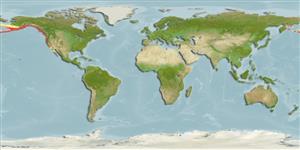Issue
Hybridizes with Platichthys stellatus - the hybrid, called Inopsetta ischyra, may be found from the Bering Sea to San Francisco, California, USA.
Environment: milieu / climate zone / depth range / distribution range
Ecology
Marine; demersal; oceanodromous (Ref. 51243); depth range 0 - 550 m (Ref. 6793). Temperate; 61°N - 28°N, 163°E - 114°W
Eastern Pacific: from Russia to Agattu Island, north to Nunivak Island, Alaska, then South to Mexico, Baja California, Mexico.
Length at first maturity / Size / Weight / Age
Maturity: Lm 31.0, range 30 - 32 cm
Max length : 49.0 cm TL male/unsexed; (Ref. 6885); 57.0 cm TL (female); common length : 33.0 cm TL male/unsexed; (Ref. 56527); max. published weight: 1.5 kg (Ref. 56527); max. reported age: 22 years (Ref. 55701)
Adults inhabit sand and mud bottoms (Ref. 4925). Young occur in intertidal areas. Feed on small crustaceans, marine worms, brittle stars and small mollusks (Ref. 6885). Spawning adults make extensive migrations (Ref. 6885).
Vinnikov, K.A., R.C. Thomson and T.A. Munroe, 2018. Revised classification of the righteye flounders (Teleostei: Pleuronectidae) based on multilocus phylogeny with complete taxon sampling. Molecular phylogenetics and evolution, 125:147-162. (Ref. 122998)
IUCN Red List Status (Ref. 130435)
Threat to humans
Harmless
Human uses
Fisheries: commercial; gamefish: yes
Tools
Special reports
Download XML
Internet sources
Estimates based on models
Preferred temperature (Ref.
123201): 3.4 - 8.3, mean 5.6 °C (based on 245 cells).
Phylogenetic diversity index (Ref.
82804): PD
50 = 1.0000 [Uniqueness, from 0.5 = low to 2.0 = high].
Bayesian length-weight: a=0.00575 (0.00358 - 0.00924), b=3.03 (2.89 - 3.17), in cm total length, based on LWR estimates for this species & (Sub)family-body (Ref.
93245).
Trophic level (Ref.
69278): 3.4 ±0.46 se; based on food items.
Generation time: 4.5 ( na - na) years. Estimated as median ln(3)/K based on 2
growth studies.
Resilience (Ref.
120179): Medium, minimum population doubling time 1.4 - 4.4 years (tm=3; tmax=22; K=0.24; Fec=150,000).
Fishing Vulnerability (Ref.
59153): Moderate vulnerability (43 of 100).
Climate Vulnerability (Ref.
125649): Low to moderate vulnerability (27 of 100).
Nutrients (Ref.
124155): Calcium = 34.1 [13.5, 59.2] mg/100g; Iron = 0.269 [0.135, 0.520] mg/100g; Protein = 16.4 [14.5, 18.6] %; Omega3 = 0.365 [0.180, 0.751] g/100g; Selenium = 20.5 [10.8, 42.8] μg/100g; VitaminA = 8.24 [1.95, 35.14] μg/100g; Zinc = 0.428 [0.290, 0.630] mg/100g (wet weight); based on
nutrient studies.
